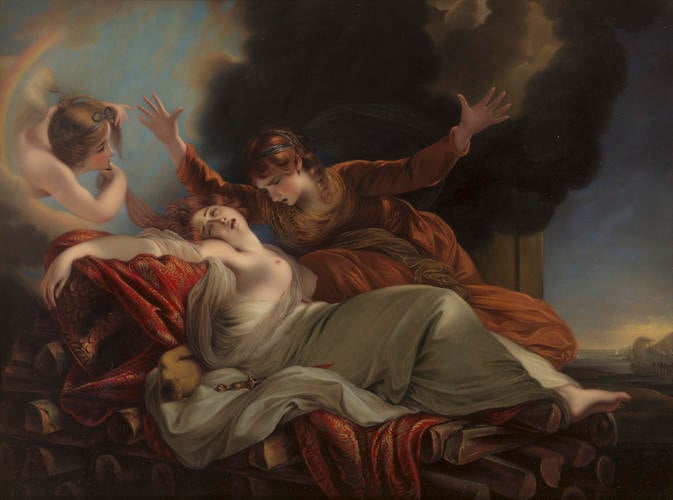The Death of Dido (after Reynolds) Signed and dated 1804
Enamel on copper | 25.1 x 33.8 cm (support, canvas/panel/stretcher external) | RCIN 404284
-
The death of Dido, Queen of Carthage, is related by Virgil in The Aeneid, book IV. Aeneas, Prince of Troy, landed on the coast of Carthage after a storm and was led by Venus, the goddess of love, to Dido. Dido and Aeneas became lovers until Mercury, the messenger of the gods, reminded Aeneas of his mission to travel to Italy. As Aeneas departed, Dido killed herself on top of a pyre that she had built. Her curse on the Trojans was eventually fulfilled in the historical wars between Carthage and Rome. In the miniature, Dido lies on her funeral pyre attended by her sister Anna while Iris, goddess of the rainbow and, like Mercury, a messenger of the gods, cuts off a lock of Dido’s hair to set her spirit free. The dagger with which she has just stabbed herself lies beside her. On the right of the picture, Aeneas can be seen putting to sea with his fleet of ships. This is a copy by Henry Bone (1755-1834) of Sir Joshua Reynolds’ picture exhibited at the Royal Academy in 1781. The original painting (RCIN 404696) remained in Reynolds’ studio until his death and was acquired by George IV 16 years after he had commissioned this copy from Henry Bone. Bone’s claim on the reverse of the enamel that Reynolds gave Dido five fingers and a thumb on her left hand, is debatable.
Bone was born in Truro in Cornwall, the son of a woodcarver and cabinet maker, and began his artistic career painting on china for local manufacturers. In about 1779, he moved to London, where he became established as one of the most outstanding enamellists of his day. His children and grandchildren also became miniaturists. He painted designs for lockets, watches and jewellery. He was principally a copyist and his large-scale enamels were based on paintings by Old Masters and leading contemporary artists. He exhibited over 240 items at the Royal Academy between 1781 and 1832, when his eyesight began to fail. He was appointed enamel painter to the future George IV in 1801, before holding the same position to George III from 1809, and later George IV and William IV. Bone could obtain top prices for his work – in 1811 he received 2,200 guineas for his framed Bacchus and Ariadne. He was described by a contemporary as a ‘worthy, kind, liberal and affectionate man’.The miniature is signed and dated on the lower left HBone 1804, and inscribed by the artist on the reverse in black paint: London April 1804 / retouched June 1804 / Painted for His Royal Highness the Prince of Wales / by Henry Bone A.R.A. Enamel Painter to H.R.H. / after the Picture by the late Sir Joshua Reynolds / painted in the Year 1786, in the possession of the / Most Noble the Marchioness of Thomond / Size of the Picture 7 feet 10 inches by 4 feet 10. / N.B. On the left hand of Iris are five / fingers and a thumb.
Provenance
Commissioned for George IV when Prince of Wales and listed in the Bone accounts for 18 July 1804: 'Enamel picture of the Death of Dido - 13 inches by 9 3/4 square - £395.15.0. - very rich carved and gilt frame - matted border - Box &c. £50.18.6'; recorded in the Prince Regent's Bedroom at Carlton House in 1819 (no 191)
-
Creator(s)
Acquirer(s)
-
Medium and techniques
Enamel on copper
Measurements
25.1 x 33.8 cm (support, canvas/panel/stretcher external)
68.5 x 76.5 x 15.8 cm (frame, external)
Category
Object type(s)
Other number(s)
Alternative title(s)
The Death of Dido









